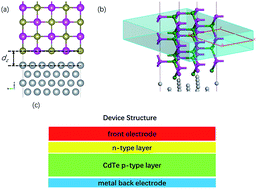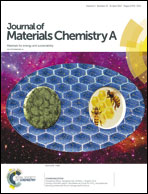Optimizing CdTe–metal interfaces for high performance solar cells†
Abstract
CdTe is widely applied in thin film solar cells as a p-type layer, which is usually in contact with a metal back electrode. Using ab initio energy band calculations, here we study the interfacial properties of CdTe (110)–metal interfaces (metals = Al, Ag, Au, Cu, and Ni) systematically. Weak chemisorption and large interfacial distances are found between CdTe and Al, Ag and Cu surfaces, while medium or strong chemisorption and small interfacial distances are found between CdTe and Au and Ni surfaces. After GW correction, it is found that CdTe forms n-type Schottky contacts with Ag, Al and Cu and p-type Schottky contacts with Au and Ni at the interface between metalized CdTe and semiconductive CdTe, consistent with previous experimental values. Besides the Schottky barrier, tunneling barriers also exist at the CdTe–metal contact interface. The potential profiles at the vertical CdTe–metal interfaces reveal that due to the medium or strong chemisorption, tunneling barrier is absent at CdTe–Au and CdTe–Ni contacts, while the weak bonding interfaces (Ag, Al and Cu) have obvious tunneling barriers. Finally, methods to optimize the interface of the CdTe–metal contact to further decrease the Schottky barrier at the CdTe–metal contact are discussed.



 Please wait while we load your content...
Please wait while we load your content...